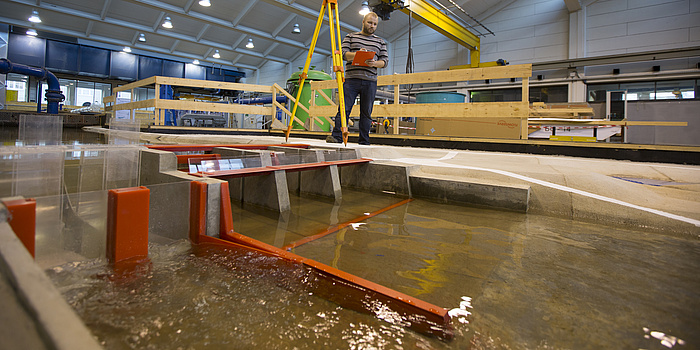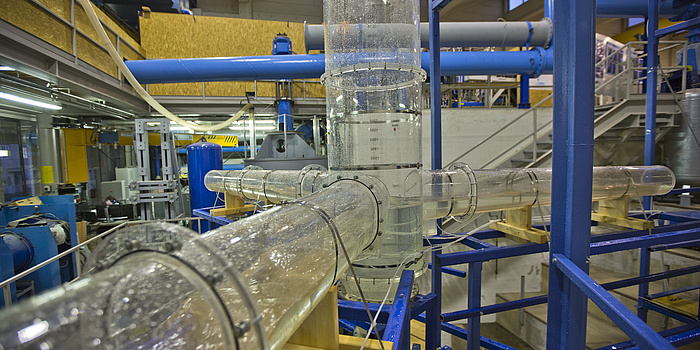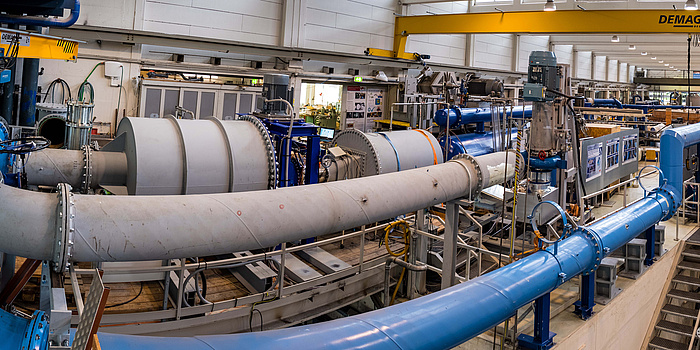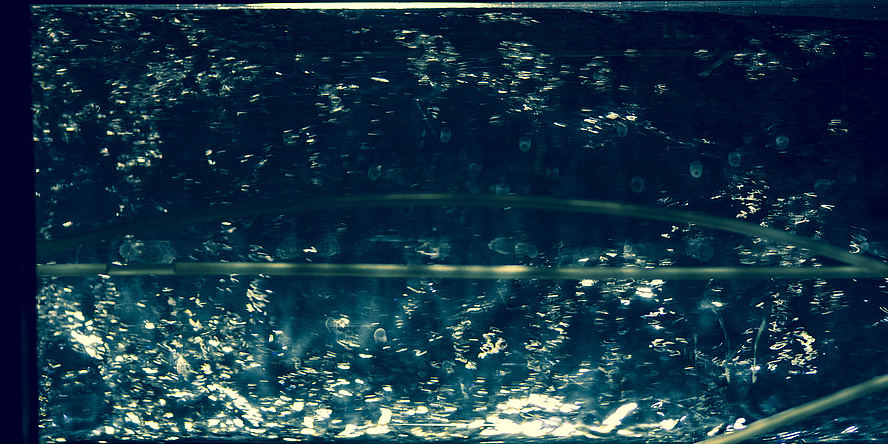"If I were to consistently pay attention to what I know, I should live a little differently," says Dirk Muschalla, who then smiles as his eyes fall on the PET bottles on his desk – iced tea and orange juice. "In Austria we are in the privileged situation of our tap water being of a higher quality than anything we can buy in the supermarket. Drinking water is a high quality food and it is only convenience to buy drinks in plastic bottles. Not to mention the ongoing discussions about microplastics in PET bottles and the possible transfer of other substances from PET, such as acetaldehyde." Muschalla, head of the Institute of Urban Water Management and Landscape Water Engineering, is one of many researchers at Graz University of Technology who are working on the precious resource of water. His special area is water supply and disposal in populated areas and those substances that are returned to the environment via wastewater.
Climate change as a major uncertainty factor
"Climate change presents us with major challenges that we cannot fully estimate today," he says, explaining what is currently driving science. Together with his team, Muschalla is investigating, for example, how global warming and associated natural events such as flooding could affect the city of Graz. The work is based on global forecasts by climate researchers. Urban flooding – such as what happened in the Graz shopping centre Citypark in April 2018 – will probably increase. In the future, rivers that burst their banks or overloaded canals will not be necessary to cause flooding. Even heavier rainfall will be enough. "Because our cities are more and more densely populated and the ground is sealed more and more compactly, the water can no longer seep away or be retained on site," explains Muschalla. "This is why the increasingly heavy rainfall is already causing flooding, even though the sewer system is not yet full. The water never gets to them but causes damage before." It can already be observed that the thunderstorm season begins unusually early and ends late in October. The heavy rainfall ensures that the ground is saturated. The consequence of this is flooding. On the other hand, the summer months are characterized by long periods of heat. Precipitation becomes rare because, due to the disproportionate heat, there is no more water stored in the soil that could evaporate.
In the project STRATUS – Spatial Rainfall Variability of Storms in Urban Runoff Simulation at the Institute of Urban Water Management and Landscape Water Engineering at TU Graz want to protect populated areas from urban flooding. They are working on simulation tools that can depict extreme precipitation events and thus contribute to the early detection of risks. The data comes from the EU project RAINMAN, where long-term precipitation and runoff behaviour were measured in defined catchment areas throughout Europe.
Play video
Dubious cocktails of substances in waste water
An additional challenge for the future is the changing demography: people are getting older and older. "As a society gets older, it needs more medication," says Muschalla. The residues of these substances are found in the waste water. "We still do not fully know today how these substances interact with each other and whether our sewage plants can effectively filter them out of the water." Muschalla's Institute is therefore also investigating which substances are present in our sewer systems in the water and are disposed of with the waste water. But it is not only drug residues that end up in waste water. Above all, other substances that the rain washes off of the ground are also problematic. "Rainwater is not pure water when it runs of the surface. Chemicals from house facades, tyre wear on the road and heavy metals from the roofs and many other sources result in a precarious mixture," says Muschalla.
Substances that have penetrated the soil through excessive fertilisation for example may also endanger the groundwater in Austria in the future. Although the substances take decades to reach the groundwater: "If they are already in the ground, then we cannot prevent them from reaching parts of the groundwater sooner or later," says Muschalla. "But what we can do today is to ensure that no more substances are added and that the good quality of our groundwater is ensured for the future.”
By the way, the water in the city of Graz is fed from three groundwater fields. One of them is located in the Graz district of Andritz, one in the south of Graz and one on the Hochschwab (mountain). The systems are designed so that the water supply in Graz is practically fail-safe: if we are not able to use one source, one or both the other two can take over.
Waste water disposal in the combined sewer system
Graz, like many other large cities, has a combined sewer system. This means that waste water from Graz households and businesses is discharged together with rainwater in one system of pipes and tunnels. During dry periods and minor rain events this has a great advantage. It means that contaminated rainwater is also treated in the sewage plant in the south of Graz before it flows into the Styrian rivers. The situation can be problematic in the event of heavy rainfall. The sewage system can no longer store the huge masses of water and lead them away to the sewage treatment plant. The excess water must be discharged into the Mur and other watercourses in Graz via regulated discharges (quasi emergency overflows). Although the mixture of rainwater and wastewater cannot be completely purified, it is at least discharged into the watercourse in very high dilution. Unfortunately, a certain pollution of the waters is unavoidable during rainy seasons. However, projects such as the central collection sewer currently under construction in Graz will help to further reduce water pollution in the future.
Most major European cities started to built their sewer systems between 1850 and 1900. Central parts of the Graz sewerage system were built around 1925. In expansion areas of our settlements the sewer network is younger. The same applies to the drinking water supply. "We are working in several projects on forecasting systems that tell us in good time when the ageing infrastructure needs to be renewed or repaired," explains Muschalla. This would make it possible to better coordinate and combine construction and renovation work in the future.
Protective measures against water masses
Green roofs are often required in order to be able to catch the water masses during rainfall. It is also a very good idea, said Muschalla: "Green roofs can store water and evaporate it again in summer. In this way, the city can be cooled at the same time." But that would not be enough. “What is needed is a combination of several decentralized and centralized measures." One of these is the central storage sewer, which is currently being built in the city centre of Graz along the Mur river. The idea is that it will temporarily store combined surface run-off and sewage and slowly release it to the sewage treatment plant. As a result, a number of overflows in the central Graz area would no longer be necessary and the River Mur would be a bit cleaner.
Hydropower as the most sustainable energy supplier of the present and future
Together with the central storage channel along the Mur, a run-of-the-river hydroelectric power station has been built – the Mur power station Graz. TU Graz’s Institute of Hydraulic Engineering and Water Management is concerned with the construction, operation and maintenance of power stations, dams and barrage walls. The researchers were and are involved in numerous renowned power plant and dam projects in Austria and with national and international partners worldwide. "Storage reservoirs with their barrier structures are not only an important means of using hydropower for electricity generation," explains Gerald Zenz, head of the Institute. "They are also an important means of protecting settlements from flooding. They can temporarily store flood inflows and release them again gradually after the flood event." Behind the bright conference table, where the researcher is talking about his work, a graphic can be seen on a large screen: all the flood protection projects along the Styrian river landscape that have already been implemented by the Styrian Water Engineering Authority and are currently being implemented are visible - and there are many of them.

In the Hydraulic Engineering Laboratory of Graz University of Technology, river courses, power plants and dams are reconstructed and examined on a small scale.
As an energy supplier, hydropower currently covers about 70 percent of Austrian electricity demand. "For me, hydropower is the most sustainable form of energy and provides the most economical way to store electrical energy from renewable sources. It has a long tradition and an excellent future", explains Zenz. This is why it is so important to get young civil engineers interested in water management. "It is true that the large hydroelectric power plants and dams have already been built, but there is still great potential worldwide and also in Austria. In addition, the plants must also be maintained and optimized so that they remain reliable energy suppliers in the future. This requires the highest level of know-how in all areas of civil engineering."
Besides run-of-the-river power plants, pumped-storage power plants are important energy storage facilities. They provide fast, clean energy at peak times and can thus compensate for the natural fluctuations to which other sustainable energy sources such as the sun or wind are subject. "Pumped-storage power plants use the water stored in storage lakes to generate energy when needed," explains Wolfgang Richter, a researcher at the Institute of Hydraulic Engineering and Water Resources Management. "If more energy is generated than society needs, we use it to pump water into the higher reservoir. If more energy is needed than can be generated, the water is fed through a pipe system through turbines that generate electricity." The latest considerations are to build underground water reservoirs as well as pipe systems and catch basins. Or to combine the underground storage tanks with a heat storage tank. "We are therefore convinced that new, additional, high-pressure pumped-storage tanks will make a significant contribution to energy innovation in the future," says Zenz.

Of pumps and turbines – the core of the power plant
"Today, water is the only large-scale technical possibility to store energy," explains Helmut Jaberg, head of the Institute of Hydraulic Fluid Machinery. He and his team are working on turbines that "extract energy from the water" and on pumps that transport it. Fields of application include, of course, different power plants, but also the transport of drinking water and waste water.
In his view, hydropower also plays an important role in the production of sustainable energy. As a producer, but above all as a control system. Within a very short period of time, it can compensate for the energy fluctuations in the grid that are caused by the increasing feed-in of solar and wind energy. Hydroelectric power plants can react extremely quickly, as Jaberg explains using the Kops power plant in Vorarlberg, which went into operation ten years ago and in which the Institute was centrally involved. "The power plant can switch from 500 kilowatts of pumping capacity to 500 kilowatts of turbine capacity within 20 seconds. In other words – within ten seconds 80 cubic metres of water per second are halted and within the next ten seconds are accelerated in the opposite direction. This is unique all over the world." Of course, this increasing need to change operation also brings with it greater wear and tear – and a new field of research for science.
Life-extending measures for pumps and turbines
This example also shows what Jaberg and his team are all about: operating turbines efficiently, achieving maximum performance quickly and cost-effectively and, above all, increasing the service life of the machines. "The main problem is cavitation," the scientist explains. "This ensures that turbines and pumps cannot achieve their full potential and have to be repaired more quickly." Cavitation means that water evaporates even when cold. This occurs when the pressure is reduced sufficiently low. At an ambient pressure of one bar – as it is in our environment – water evaporates at 100° Celsius. If the pressure is lower, it evaporates at lower temperatures – at a pressure of 0.0234 bar, for example, at 20° Celsius. And this happens very quickly in turbines, as Jaberg explains: "When turbines set the water in motion, small steam bubbles form. If the ambient pressure increases again and the bubbles deform, a pressure of several thousand bar is created inside them. Inevitably, the steam bubbles implode and the resulting micro-jets hit the surrounding walls and turbine blades at an incredible speed, thus damaging them." This phenomenon needs to be countered scientifically.

In addition, the researchers are also looking into pressure surges, which are a particular problem in pumped-storage power plants. If the operating point, i.e. the water flow, of a power plant, for example, is changed quickly because the electrical network has to be regulated, these changes cause enormous pressure surges which the structures have to withstand. "We deal with the cause of the pressure surges – the pumps, turbines and valves – and try to suppress them as far as possible or keep them to a minimum," explains Jaberg. "And our colleagues in hydraulic engineering make sure that the structures are able to withstand the pressure surges when they are unavoidable." After all: "A power plant must never and under no circumstances pose a danger to employees or, of course, to the environment."
Climate protection and conservation of resources
Due to its geography and geology, Austria still has an advantage over other world regions when it comes to the supply of clean water. But also because Austria effectively protects its water resources. And this is sometimes at the expense of other nations. "Austria does not import water directly, but via goods such as avocados, which are cultivated in South America with high water consumption," explains Muschalla. And Zenz adds: "All you see here is a power plant that is naturally large in relation to a filling station and takes up a lot of natural space. But what you don't see are the oil fields from which fossil fuels are extracted – which we use as imported energy sources – and which have a major impact on climate and nature and are associated with high external costs that are not taken into account."
Of course, river and pumped-storage power plants also have an impact on nature, adds Jaberg: "Every engineer has to admit this, too." But: "I believe that hydropower will be an indispensable factor – because of its fast reaction time and high storage capacity. However, I fear that we will not be able to build as many pumped-storage power plants in Europe as a complete switch to renewable energy production would require. Here, technology is facing very great challenges – in all areas."
Degree and Certificate Programmes at TU Graz:
Bachelor´s Degree Programmes
- Civil Engineering and Construction Management
- Environmental Systems Sciences / Natural Sciences – Technology
- Geosciences
Master´s Degree Programmes
- Geotechnical and Hydraulic Engineering
- Geosciences
- Environmental System Sciences / Climate Change and Environmental Technology
- Civil Engineering – Infrastructure

